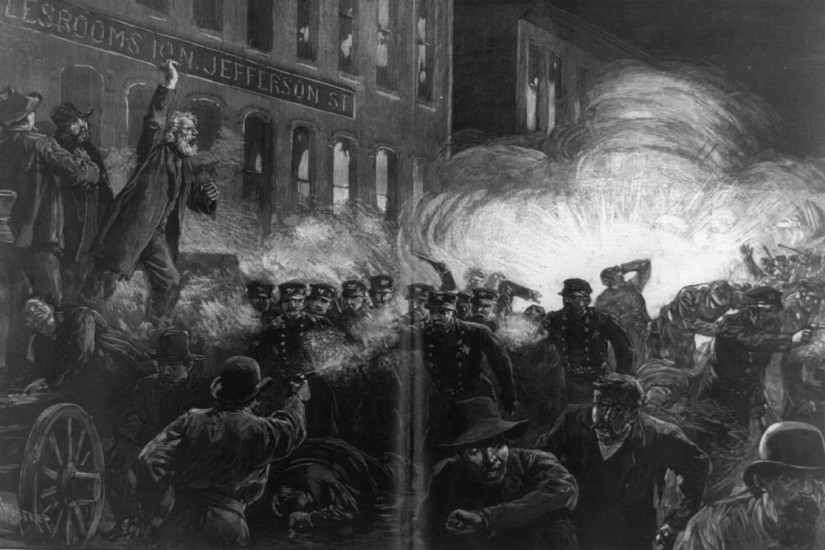The demands of the militant Chicago anarchists coincided with a massive upswing in other militant movements. Workers and Texas farmers were rebelling against a monopolistic railroad system. The Knights of Labor were rapidly organizing and spreading their vision of a cooperative, rather than capitalistic, society. “What happened on May 1, 1886,” writes James Green, the most recent and most accessible historian to have written about it, “was more than a general strike; it was a ‘populist moment’ when working people believed they could destroy plutocracy, redeem democracy and then create a new ‘cooperative commonwealth.’”
Four days later, it all came crashing down. On May 3, police had shot to death six strikers at the McCormick Works, where a long-standing labor dispute had turned the factory into an armed camp, and beaten dozens more. On May 4, anarchists held an outdoor indignation meeting at a square called the Haymarket to protest the police murders. Anarchist leader Samuel Fielden was wrapping up his speech when the police, led by the same inspector who had led the charge at McCormick the night before, moved in to disperse the crowd. “But we are peaceable!” Fielden cried, and just then somebody wasn’t. Somebody threw a bomb at the police, the police open fire, and the course of American history changed.
To this day we do not know, nor will we likely ever know, who threw the bomb. Some say it was an agent provocateur. Some say it was an anarchist. If it wasn’t an anarchist, it surely could have been, since there were indeed anarchists who made bombs and would have thrown one given the opportunity. But we also know that many of those who died that night, including police, were felled by the police bullets.
We also know that the effect of the Haymarket bombing was far greater on the labor movement than it was on the police. Eight anarchist leaders were rounded up and put on trial for the murder of a police officer. No evidence was ever given that any of them threw the bomb, and only the flimsiest evidence was presented that any of them were remotely involved. All eight were convicted, and seven were sentenced to hang. Two of these had their sentences commuted, and a third—Louis Lingg, undoubtedly the most radical and militant of them—cheated the hangman by chewing a detonator cap and blowing off his jaw. The remaining four—August Spies, Albert Parsons, Samuel Fischer, and George Engel—were hanged on November 11, 1887. They went to their deaths singing the Marseillaise, then an anthem of the international revolutionary movement, and before he died, Spies shouted out his famous last words: “The time will come when our silence will be more powerful than the voices you strangle today.”
Before that happened, the state ensured more silence. The strike collapsed. Police around the country raided radicals’ homes and newspapers. The Knights of Labor never recovered. In the place of the radical industrial labor movement of the mid-1880s rose the American Federation of Labor, the much more exclusive and conservative organization that would dominate the labor movement until the 1930s. Meanwhile, it would take until the Fair Labor Standards Act of 1938 to finally enshrine the eight-hour day into federal law.
May 1 would live on, mostly abroad. In 1889, French syndicalist Raymond Lavigne proposed to the Second International—the international and internationalist coalition of socialist parties—that May 1 be celebrated internationally the next year to honor the Haymarket Martyrs and demand the eight-hour day, and the year after that the International adopted the day as an international workers’ holiday. In countries with strong socialist and communist traditions, May 1 became the primary day to celebrate work, workers and their organizations, often with direct and explicit reference to the Haymarket Martyrs. May Day remains an official holiday in countries ranging from Argentina to India to Malaysia to Croatia—and dozens of countries in between.
